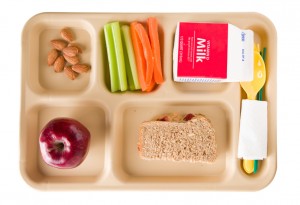Anyone who went to high school in the past 50 years undoubtedly knew about the “Snack Shack” or other dispensary that sold everything from sugary drinks to potato chips and beef jerky. The USDA has proposed nutrition standards that will mean all foods and beverages sold in schools must meet healthy nutrition standards.
 The Centers for Disease Control and Prevention calls these foods “competitive foods“. They “compete” with school meals and most are high in added sugars, fats, artificial ingredients, trans fats, and sodium. The Nutrition Standards for Foods in Schools recommended by the Institute of Medicine divides these foods into tiers. In Tier 1, healthy foods are available for all students at all times of the day. In Tier 2, snack foods that meet nutritional requirements, such as low salt baked potato chips and graham crackers, are available for high school students after school only. Items that do not meet the standards include products with lots of fat and sugar, such as gum, candy, colas, cakes, cupcakes, granola bars, and ice cream.
The Centers for Disease Control and Prevention calls these foods “competitive foods“. They “compete” with school meals and most are high in added sugars, fats, artificial ingredients, trans fats, and sodium. The Nutrition Standards for Foods in Schools recommended by the Institute of Medicine divides these foods into tiers. In Tier 1, healthy foods are available for all students at all times of the day. In Tier 2, snack foods that meet nutritional requirements, such as low salt baked potato chips and graham crackers, are available for high school students after school only. Items that do not meet the standards include products with lots of fat and sugar, such as gum, candy, colas, cakes, cupcakes, granola bars, and ice cream.
The Center for Science in the Public Interest has released a statement from CSPI Nutrition Policy Director Margo C. Wootan praising this move. She said, “under USDA’s proposed nutrition standards, parents will no longer have to worry that their kids are using their lunch money to buy junk food at school.” Two-thirds of elementary school students and almost all high school students can buy foods and beverages that are not part of the meal programs. These junk foods contribute to the childhood obesity epidemic and provide empty calories with little nutrition.
Ms. Wootan added, “current national school nutrition standards for foods sold outside of meals only limit ‘foods of minimal nutritional value’ such as seltzer water, hard candy, and ice pops, not candy bars, snack cakes, and sports drinks.” In addition, these standards will address unhealthy ingredients such as trans fats, salt, and added sugars.
The National Alliance for Nutrition & Activity has released a fact sheet on this issue. It states that between 1991 and 2008, the percentage of middle schools with vending machines increased from 42% to 77%, and the percentage of high schools from 76% to 96%. Over the last two decades, obesity rates have tripled in children and adolescents.
The Alliance states that minimum national nutrition standards for foods sold outside of school meals are needed to protect the integrity of the school lunch program and the health of all children in all states. Two-thirds of states have weak or no nutrition standards for foods sold outside of meals, so a federal standard is needed. These rules do not apply to snacks or lunches students bring from home or to foods sold at after school events.




